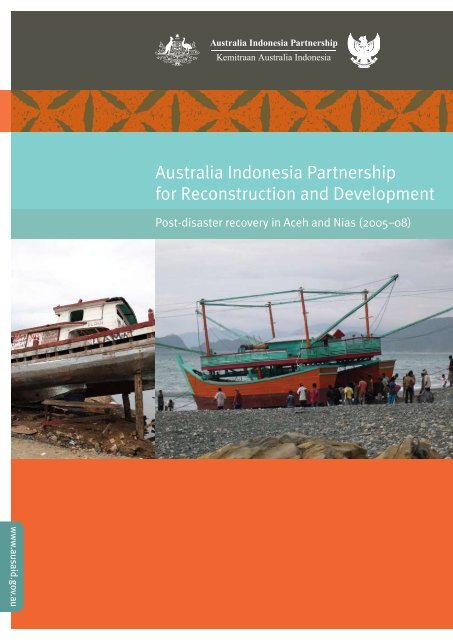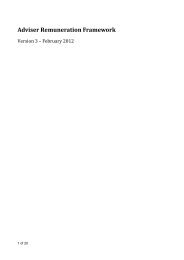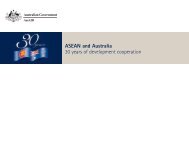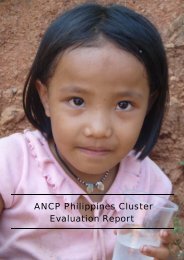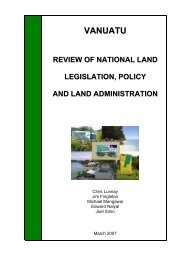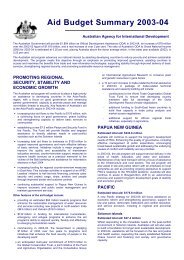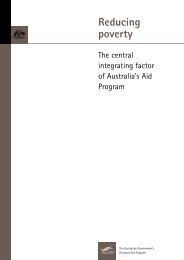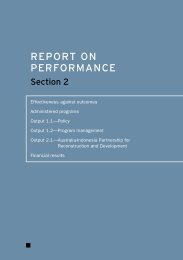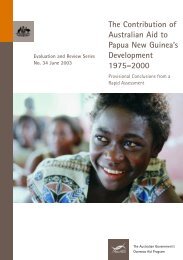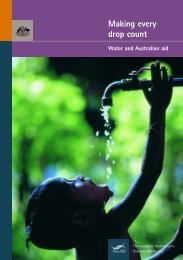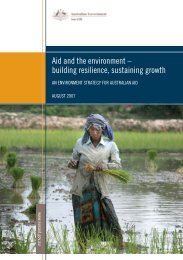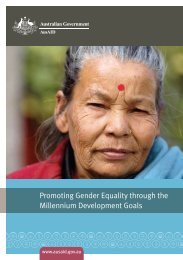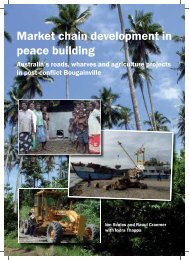Australia Indonesia Partnership for Reconstruction and ... - AusAID
Australia Indonesia Partnership for Reconstruction and ... - AusAID
Australia Indonesia Partnership for Reconstruction and ... - AusAID
- No tags were found...
You also want an ePaper? Increase the reach of your titles
YUMPU automatically turns print PDFs into web optimized ePapers that Google loves.
© Commonwealth of <strong>Australia</strong> 2008This work is copyright. Apart from any use aspermitted under the Copyright Act 1968, no partmay be reproduced by any process without priorwritten permission from the Commonwealth.Requests <strong>and</strong> inquiries concerning reproduction<strong>and</strong> rights should be addressed to theCommonwealth Copyright Administration,Attorney General’s Department, Robert GarranOffices, National Circuit, Barton ACT 2600 orposted at http://www.ag.gov.au/ccaISBN 978-1-921285-58-5Published by the <strong>Australia</strong>n Agency <strong>for</strong>International Development (<strong>AusAID</strong>), Canberra,November 2008.This document is online at:www.ausaid.gov.au/publicationsFor more in<strong>for</strong>mation about the <strong>Australia</strong>nGovernment’s international developmentprogram, contact:Communications Section<strong>AusAID</strong>GPO Box 887Canberra ACT 2601Phone +61 2 6206 4000Facsimile +61 2 6206 4880Internet www.ausaid.gov.auEdited by Clarity Communications <strong>Australia</strong>Designed by GRi.D, CanberraPrinted by BluestarCover: Launching of traditional fishing boat. Thefishing industry which was devastated by thetsunami has been rebuilt. Photo: <strong>AusAID</strong>
Executive summaryThree <strong>and</strong> a half years after the Boxing Day 2004 tsunami, tangible results of reconstructionare evident in the province of Aceh. Communities have been restored, <strong>and</strong> some arethriving. Children have long since returned to the many schools that have been rebuilt.While the physical, economic <strong>and</strong> emotional scars of the earthquake <strong>and</strong> tsunami remain,the reconstruction of the province is well advanced <strong>and</strong> the town of B<strong>and</strong>a Aceh is alivenight <strong>and</strong> day.Along the area most severely affected—the west coast—there are banks of new houses<strong>and</strong> freshly painted village halls, schools <strong>and</strong> health clinics. The town of Calang, whichexperienced the death of more than 80 per cent of its population <strong>and</strong> became completelyinaccessible by road, now has markets, restaurants, coffee shops <strong>and</strong> a new hotel. Roadsare being repaired <strong>and</strong> bridges are being built.The outlook <strong>for</strong> the Acehnese people is also more positive following the cessation of30 years of conflict. People can now travel throughout the province with less concern<strong>for</strong> their safety since the signing of the Memor<strong>and</strong>um of Underst<strong>and</strong>ing (MoU) onDemobilization, Demilitarization <strong>and</strong> Reintegration in August 2005. According to one<strong>for</strong>mer activist: ‘… this is the best time in Aceh in the last 30 years’.The <strong>Australia</strong>n Government has committed more than $250 million in emergency response<strong>and</strong> reconstruction assistance. This includes a significant contribution from the $1 billionpackage of assistance to <strong>Indonesia</strong>—known as the <strong>Australia</strong> <strong>Indonesia</strong> <strong>Partnership</strong> <strong>for</strong><strong>Reconstruction</strong> <strong>and</strong> Development (AIPRD).This much-needed aid has supported the recovery of communities in many ways,including through the reconstruction of public infrastructure in Aceh <strong>and</strong> Nias, such asschools, health facilities <strong>and</strong> the port at B<strong>and</strong>a Aceh. <strong>Australia</strong>n ef<strong>for</strong>ts have focused onconsolidating investments in physical reconstruction by helping the Acehnese develop theskills necessary to manage continuing improvements in these sectors.The loss of life following the tsunami hit the health <strong>and</strong> education sectors hard withthe loss of thous<strong>and</strong>s of doctors, nurses <strong>and</strong> teachers. <strong>Australia</strong>, through the <strong>Australia</strong>nAgency <strong>for</strong> International Assistance (<strong>AusAID</strong>) has provided training to rebuild these lostskills, including <strong>for</strong> 230 hospital workers, thous<strong>and</strong>s of nurses <strong>and</strong> midwives, <strong>and</strong>1750 teachers. New technical training facilities <strong>and</strong> management systems have been put inplace to provide future generations of professionals in these sectors with the skills requiredto deliver high-quality services.<strong>AusAID</strong> has also worked closely with communities <strong>and</strong> local government in disasteraffectedareas to establish ‘one-stop-shops’ to improve the delivery of local governmentservices to the people of Aceh. Village elections have been revitalised with <strong>Australia</strong>nassistance, <strong>and</strong> community participation in the electoral process has been enhanced,which is helping to ensure local governments are held to account <strong>for</strong> their actions. <strong>AusAID</strong>has also worked with communities on the remote isl<strong>and</strong> of Nias to restore essential<strong>Australia</strong> <strong>Indonesia</strong> <strong>Partnership</strong> <strong>for</strong> <strong>Reconstruction</strong> <strong>and</strong> Development1
community infrastructure <strong>and</strong> improve government capacity to maintain <strong>and</strong> managerebuilt infrastructure.<strong>Australia</strong>n assistance has also played a small but important role in helping people return toincome-generating work. In aquaculture, <strong>AusAID</strong> has worked with farmers <strong>and</strong> governmentoutreach workers to increase yields of crops such as prawns. The <strong>Australia</strong>n Governmenthas also employed thous<strong>and</strong>s of Acehnese workers on its reconstruction projects <strong>and</strong> hastrained local tradesmen in housing construction <strong>and</strong> advocacy so they can both build <strong>and</strong>advocate <strong>for</strong> better-quality housing.However, the devastation suffered in Aceh <strong>and</strong> Nias as a result of one of the deadliestdisasters in modern history cannot be underestimated. Neither can the impact sufferedby the people from the proceeding 30-year conflict. <strong>Reconstruction</strong> has progressed, butmany issues related to the conflict remain unresolved. Former Free Aceh Movement(Gerakan Aceh Merdeka—GAM) combatants, <strong>for</strong> example, are experiencing high levels ofunemployment. Tensions also remain regarding the inequitable distribution of resourcesacross the province, with high levels of aid going to tsunami-affected areas. Supportingstability <strong>and</strong> peace, <strong>and</strong> rebuilding communities, remain significant challenges <strong>for</strong> thepeople of Aceh, government, civil society groups <strong>and</strong> international donors.The job is far from over. <strong>Australia</strong> is committed to supporting Aceh’s success beyond thereconstruction ef<strong>for</strong>t <strong>and</strong> to ushering in a new era of prosperity <strong>for</strong> the province.This report details the achievements of the <strong>Australia</strong>n reconstruction program in Aceh <strong>and</strong>Nias, <strong>and</strong> points to a positive future <strong>for</strong> the province.Total <strong>Australia</strong>n expenditure in Aceh <strong>and</strong> Nias to June 2008Funding commitment source Total commitment Spent to June 2008($ million) ($ million)Immediate humanitarian assistance—<strong>AusAID</strong> 34.4 34.4Immediate humanitarian assistance—other <strong>Australia</strong>nGovernment departments (primarily Defence under‘Operation Sumatra Assist’)37.4 37.4AIPRD Aceh <strong>and</strong> North Sumatra project commitments 181.0 154.9Aceh Rehabilitation Programs—restoring health, education<strong>and</strong> local government services ($80 million)Community infrastructure ($25 million)Livelihoods—restoring aquaculture <strong>and</strong> cropping($5 million)Education research <strong>and</strong> training ($3 million)Housing <strong>and</strong> temporary shelter ($10 million)Rebuilding schools in conflict-affected areas ($10 million)Regional enterprise development ($7 million)Nias community infrastructure <strong>and</strong> technical assistance($10 million)Aerial mapping ($10 million)Ulee Lheue port ($8 million)Humanitarian food aid ($10 million)Technical assistance <strong>for</strong> improved governance ($3 million)Total 252.8 226.7* All dollar figures are in AUD unless specified otherwise.2<strong>Australia</strong> <strong>Indonesia</strong> <strong>Partnership</strong> <strong>for</strong> <strong>Reconstruction</strong> <strong>and</strong> Development
BackgroundThe Indian Ocean earthquake <strong>and</strong> tsunami disaster of 26 December 2004 caused massivedevastation in Aceh, <strong>Indonesia</strong>’s western-most region. An estimated 167 000 people died <strong>and</strong>around 500 000 were left homeless. Some 800 kilometres of coastline were destroyed <strong>and</strong>more than 3000 hectares of l<strong>and</strong> washed away or badly inundated by seawater. Ports, roads<strong>and</strong> bridges were also destroyed. Thous<strong>and</strong>s of schools, health facilities <strong>and</strong> water sourceswere damaged or destroyed <strong>and</strong> sources of local livelihoods debilitated. 1The isl<strong>and</strong> of Nias suffered the dual impact of the tsunami <strong>and</strong> a massive earthquakeon 28 March 2005. The isl<strong>and</strong>—already facing difficulties because of its isolation<strong>and</strong> inadequate income opportunities, limited human resource capacity <strong>and</strong> poorinfrastructure—lost 11 ports, 403 bridges <strong>and</strong> more than 1000 kilometres of local <strong>and</strong>provincial roads.Above: Free Aceh Movement (GAM) combatantsh<strong>and</strong> over their weapons in 2005 following thesigning of the MoU that ended 30 years of civilconflict. Photo: AP/AAP/Binsar BakharaLeft: The <strong>Australia</strong>n Government respondedquickly <strong>and</strong> generously to the disaster,committing more than $250 million to the NorthSumatra emergency <strong>and</strong> reconstruction ef<strong>for</strong>t.Photo: R. MacColl1 World Bank, June 2005. <strong>Indonesia</strong>: Rebuilding a better Aceh <strong>and</strong> Nias: Preliminary stock take of the reconstructionef<strong>for</strong>t six months after the earthquake <strong>and</strong> tsunami, p. xiii.<strong>Australia</strong> <strong>Indonesia</strong> <strong>Partnership</strong> <strong>for</strong> <strong>Reconstruction</strong> <strong>and</strong> Development3
<strong>Australia</strong>ns responded quickly <strong>and</strong> generously to the disaster. Defence <strong>for</strong>ce personnel,nurses, doctors, logisticians <strong>and</strong> aid workers were some of the first rescue teams on theground in Aceh. From those early days <strong>Australia</strong> committed to working closely with the<strong>Indonesia</strong>n Government to attend to the immediate needs of the survivors <strong>and</strong> to startto put in place the people <strong>and</strong> institutional architecture needed to deal with the massiverehabilitation <strong>and</strong> reconstruction task ahead.Within days of the disaster <strong>Australia</strong> announced a five-year, A$1 billion package ofassistance to <strong>Indonesia</strong>. The AIPRD, managed jointly by the governments of both countries,has since supported reconstruction <strong>and</strong> development ef<strong>for</strong>ts in <strong>and</strong> beyond tsunamiaffectedareas.Within days of the disaster<strong>Australia</strong> announced afive-year, $1 billion packageof assistance to <strong>Indonesia</strong>.The AIPRD, managed jointlyby the governments ofboth countries, has sincesupported reconstruction<strong>and</strong> development ef<strong>for</strong>tsin <strong>and</strong> beyond tsunamiaffectedareas.The <strong>Australia</strong>n Government committed more than $250 million to the North Sumatraemergency <strong>and</strong> reconstruction ef<strong>for</strong>t. This includes $181 million in AIPRD funds <strong>for</strong>reconstruction <strong>and</strong> rehabilitation activities in Aceh <strong>and</strong> Nias. <strong>Australia</strong>ns also privatelydonated more than $350 million <strong>for</strong> tsunami relief <strong>and</strong> reconstruction programs deliveredby Non-Government Organisations (NGOs).The <strong>Australia</strong>n Government program in Aceh has focused on the sectors most critical <strong>for</strong>reconstruction: health, education, infrastructure, livelihoods <strong>and</strong> governance. This hasincluded the rebuilding of community facilities such as the emergency ward of the mainhospital in B<strong>and</strong>a Aceh, health clinics, schools <strong>and</strong> village halls across the province.<strong>Australia</strong>’s assistance has also helped address the significant skills shortages caused by thetsunami with the loss of thous<strong>and</strong>s of doctors, nurses, teachers <strong>and</strong> government officials.Since the tsunami real opportunities have emerged <strong>for</strong> peace <strong>and</strong> development in Aceh.The province is recovering not only from the tsunami but also from more than 30 yearsof conflict between the Government of <strong>Indonesia</strong> <strong>and</strong> the GAM. Be<strong>for</strong>e the tsunami, anestimated 1.2 million people (28.5 per cent) lived below the poverty line. Capacity <strong>for</strong> servicedelivery <strong>and</strong> governance was weak <strong>and</strong> fractured.In 2004, Aceh was the fourth-poorest province in <strong>Indonesia</strong>. Two years after the tsunamipoverty levels increased further, leaving Aceh the second-poorest in <strong>Indonesia</strong>. Povertylevels are now improving as a result of the peace process <strong>and</strong> reconstruction ef<strong>for</strong>t. 2The MoU signed in August 2005 between the Government of <strong>Indonesia</strong> <strong>and</strong> the FreeAceh Movement has resulted in the surrender of weapons by GAM, the demobilisation ofthous<strong>and</strong>s of <strong>for</strong>mer political prisoners <strong>and</strong> combatants <strong>and</strong> the redeployment from Acehof government troops <strong>and</strong> police.In December 2006, a <strong>for</strong>mer GAM leader was elected Governor of Aceh in peaceful elections.Since the signing of the MoU, trust between the two sides has increased. Also, since thepassing of the Law on Governing Aceh in 2006, Aceh has obtained a degree of economic<strong>and</strong> political autonomy. The challenge <strong>for</strong> Aceh now is to manage the broad range ofpowers <strong>and</strong> responsibilities that have been devolved to the region.This report gives an overview of the achievements of the <strong>Australia</strong>n reconstruction programin Aceh <strong>and</strong> Nias, draws lessons from the unprecedented reconstruction ef<strong>for</strong>t <strong>and</strong>discusses <strong>AusAID</strong>’s transition to ongoing development work in the province.2 World Bank, 2008. Aceh Poverty Assessment 2008: The Impact of the Conflict, the Tsunami <strong>and</strong> <strong>Reconstruction</strong> onPoverty in Aceh, Jakarta.4 <strong>Australia</strong> <strong>Indonesia</strong> <strong>Partnership</strong> <strong>for</strong> <strong>Reconstruction</strong> <strong>and</strong> Development
Program design <strong>and</strong> approachAfter the immediate emergency following the tsunami was brought under control in Aceh,the sheer enormity of the technical, logistical, social <strong>and</strong> regulatory challenges becameapparent. As the death toll mounted <strong>and</strong> the full extent of damage <strong>and</strong> loss emerged, therealisation dawned that reconstructing schools, roads, ports <strong>and</strong> houses was only part ofthe job ahead. Rebuilding the capacity of Aceh’s work<strong>for</strong>ce was to be just as challenging.Every sector of Aceh was in dire need of assistance.Hundreds of donors <strong>and</strong> NGOs poured into Aceh with billions of dollars in donations to gotoward reconstruction. <strong>AusAID</strong> set out to establish a significant, yet short- to medium-termresponse to the disaster in a difficult operating environment.Following 30 years of conflict in the region, the Aceh Rehabilitation Program startedfrom virtually a ‘zero base’. Be<strong>for</strong>e the tsunami, there were few donors or NGOs operatingin Aceh, no existing arrangements upon which to build, no staff on the ground <strong>and</strong> nosupply chains.The goal of the AcehRehabilitation Program was tocontribute to the recovery <strong>and</strong>development of Aceh <strong>and</strong> Niasin ways that would meet theneeds <strong>and</strong> aspirations of itspeople <strong>and</strong> communities.<strong>Australia</strong>’s partnership with <strong>Indonesia</strong> became the cornerstone of <strong>AusAID</strong>’s ef<strong>for</strong>ts in Aceh.The AIPRD introduced a new agreement <strong>for</strong> a closer development partnership betweenthe <strong>Australia</strong>n <strong>and</strong> <strong>Indonesia</strong>n governments. The AIPRD <strong>for</strong>malised a government-togovernmentcommitment to partnership at the highest level.<strong>AusAID</strong> took a pragmatic approach to developing the suite of programs that together makeup the Aceh Rehabilitation Program. To be effective, the programs needed to respond to thechanging environment, build on activities that were working <strong>and</strong> remain flexible.Above: Aceh communities look to the future.Photo: R. MacCollLeft: Aceh after the disaster. Photo: R. MacColl<strong>Australia</strong> <strong>Indonesia</strong> <strong>Partnership</strong> <strong>for</strong> <strong>Reconstruction</strong> <strong>and</strong> Development5
Formal <strong>and</strong> in<strong>for</strong>mal partnerships were established at every level. Decisions regardingallocation of funds were made by a Joint Commission overseen by the <strong>Australia</strong>n PrimeMinister <strong>and</strong> the <strong>Indonesia</strong>n President, <strong>and</strong> the <strong>for</strong>eign affairs ministers <strong>and</strong> economicministers from both countries. Advisers worked closely with the officials of the <strong>Indonesia</strong>nGovernment who were responsible <strong>for</strong> reconstruction. Sector program managers wereplaced in provincial government offices <strong>and</strong> a wide network of locally engaged staffemployed by <strong>AusAID</strong> worked at the village level.This approach was valued by both the <strong>Indonesia</strong>n Government <strong>and</strong> the Acehnesepopulation. <strong>Australia</strong> became known as a partner that understood Aceh’s needs <strong>and</strong> couldbe called upon when challenges had to be tackled. 3Program goal <strong>and</strong> principlesThe goal of the Aceh Rehabilitation Program was to contribute to the recovery <strong>and</strong>development of Aceh <strong>and</strong> Nias in ways that would meet the needs <strong>and</strong> aspirations of itspeople <strong>and</strong> communities.To ensure this goal was reflected in all of <strong>AusAID</strong>’s work, five principles were defined toguide the design <strong>and</strong> development of <strong>Australia</strong>’s assistance in Aceh:1. Work alongside national <strong>and</strong> provincial governmentsThe <strong>for</strong>mal partnership between the <strong>Australia</strong>n <strong>and</strong> <strong>Indonesia</strong>n governments ensured<strong>AusAID</strong> sought the early <strong>and</strong> continuing involvement of <strong>Indonesia</strong> in developing <strong>and</strong>delivering the reconstruction program. Programs worked through existing systems,rebuilding <strong>and</strong> strengthening them in the process. Where possible, <strong>AusAID</strong> teams wereplaced in local government offices.2. Leverage funds <strong>and</strong> complement other programsIt was not a lack of funds but complex logistical <strong>and</strong> planning challenges that causeddifficulties <strong>and</strong> slowed down reconstruction. <strong>AusAID</strong> worked to complement <strong>Indonesia</strong>nGovernment <strong>and</strong> other donor programs <strong>and</strong> to strategically fill the gaps impeding progress.3. Focus on essential services<strong>AusAID</strong> focused only on sectors that provided essential services to the population. Trainingteachers <strong>and</strong> nurses, rebuilding schools, providing essential equipment <strong>and</strong> resources, <strong>and</strong>streamlining administrative processes of local governments had an immediate effect on thequality of public services delivered to tsunami victims.4. Target the most vulnerable <strong>and</strong> poor<strong>AusAID</strong> worked hard to maintain a focus on meeting the needs of people first, <strong>and</strong> thenfinding ways to implement good ideas. <strong>AusAID</strong> quickly deployed <strong>and</strong> placed numerousadvisors in local institutions (government <strong>and</strong> civil society) to gather in<strong>for</strong>mation aboutneeds, seek out where <strong>AusAID</strong> could be most helpful <strong>and</strong> develop a program from there.5. Work in areas where <strong>AusAID</strong> has a comparative advantageEven though <strong>AusAID</strong> did not have a program of assistance in Aceh be<strong>for</strong>e the tsunami,<strong>Australia</strong>ns had a wealth of experience in other parts of <strong>Indonesia</strong>. By carefully teaming upthis expertise with Acehnese advisors, <strong>AusAID</strong> could adapt proven methods of interventionto specific Acehnese circumstances.3 Based on the findings of an independent review of the AIPRD conducted in 2008.6 <strong>Australia</strong> <strong>Indonesia</strong> <strong>Partnership</strong> <strong>for</strong> <strong>Reconstruction</strong> <strong>and</strong> Development
Report against sectoral outcomesThe Aceh Rehabilitation Program commenced in January 2005 as a medium-termreconstruction program. <strong>AusAID</strong> developed programs in health, education, infrastructure,governance, <strong>and</strong> livelihoods <strong>for</strong> disaster-affected areas in Aceh <strong>and</strong> on the isl<strong>and</strong> of Nias,focusing on these outcomes:> services—health <strong>and</strong> education services that meet the needs of the people of Aceh, inwhich they can have confidence> infrastructure—infrastructure <strong>and</strong> equipment that is used well <strong>and</strong> can be maintained> governance—communities <strong>and</strong> governments that work together to meet community needs> livelihoods—support structures <strong>and</strong> systems that assist economic growth.<strong>Australia</strong>’s key achievements against these sectoral outcomes are detailed throughoutthis section.HealthCommitmentExpenditure estimate as at June 2008$28.2 million$28.1 millionDamageThree decades of conflict, combined with the impact of the tsunami, left health services<strong>and</strong> infrastructure in dire shape <strong>and</strong> unable to adequately meet the province’s needs. Morethan 120 health facilities were damaged or destroyed. Aceh’s main hospital, Rumah SakitZainoel Abidin, was badly damaged in the tsunami <strong>and</strong> 10 per cent of its medical staffwent missing or were declared dead. At least seven other hospitals <strong>and</strong> 11 provincial healthcentres were destroyed.Achievements summary> restored emergency health care at the Zainoel Abidin Hospital> re-established administration systems at the Zainoel Abidin Hospital> established medical skills laboratories at Syiah Kuala University <strong>and</strong> Zainoel AbidinHospital to train future health professionals> improved provincial health-service management processes> upgraded four health clinics <strong>and</strong> reconstructed a midwifery academy> reconstructed two pharmaceutical warehouses <strong>and</strong> re-established medical supply chains> refurbished buildings <strong>and</strong> laboratories at B<strong>and</strong>a Aceh’s Health Technical CollegeOne of <strong>Australia</strong>’s mostimportant contributionsduring 2007 was theestablishment of facilitiesto train <strong>and</strong> develop futuregenerations of Acehnesehealth professionals.<strong>Australia</strong> <strong>Indonesia</strong> <strong>Partnership</strong> <strong>for</strong> <strong>Reconstruction</strong> <strong>and</strong> Development7
<strong>Australia</strong> has helped to restore essentialhealth services in Aceh.Right: Restoring physical infrastructuresuch as the Emergency Ward at the mainhospital in B<strong>and</strong>a Aceh. Photo: M. AnsharAbove: Restoring <strong>and</strong> upgrading trainingfacilities such as the midwifery academy.Photo: <strong>AusAID</strong>> provided training <strong>and</strong> professional development <strong>for</strong> more than 230 hospital staff> awarded more than 3700 scholarships to nursing, midwifery <strong>and</strong> healthcare studentsProvincial health-servicemanagement wasstrengthened throughtargeted assistance todepartmental planning <strong>and</strong>budgeting.Achievements, 2007-08<strong>Australia</strong> responded quickly to needs in the health sector by restoring emergencyhealth care at Zainoel Abidin Hospital—Aceh’s major hospital. This facility is now fullyoperational <strong>and</strong> is treating more than 1000 patients a month. The health service was furtherstrengthened through the training of health workers.Provincial health-service management was strengthened through targeted assistance todepartmental planning <strong>and</strong> budgeting. With <strong>Australia</strong>’s help, the Provincial Health Officein Aceh was refurbished <strong>and</strong> Aceh’s first strategic health plan <strong>and</strong> health action plans arebeing implemented.One of <strong>Australia</strong>’s most important contributions during 2007 was the establishment offacilities to train <strong>and</strong> develop future generations of Acehnese health professionals.Undergraduate medical students can now learn to use the most modern techniques <strong>and</strong>equipment available in <strong>Indonesia</strong> in the laboratory established at Syiah Kuala University.The laboratory will train some 1000 students annually, producing approximately200 graduates each year.Post-graduate students will study real-life cases at Syiah Kuala University. In addition,<strong>Australia</strong> supported the refurbishment of the environmental <strong>and</strong> microbiology laboratory,the nutrition laboratory <strong>and</strong> the main administration buildings at the Health TechnicalCollege in B<strong>and</strong>a Aceh.8<strong>Australia</strong> <strong>Indonesia</strong> <strong>Partnership</strong> <strong>for</strong> <strong>Reconstruction</strong> <strong>and</strong> Development
EducationCommitmentExpenditure estimate as at June 2008$45.25 million$36.3 millionDamageThe tsunami devastated the education sector in Aceh. More than 2100 schools weredamaged or destroyed, including more than 1500 primary schools, nearly 300 juniorsecondary schools, as well as kindergartens, technical <strong>and</strong> vocational schools <strong>and</strong>institutes of higher education. About 2500 teachers <strong>and</strong> 38 000 students died in the disaster<strong>and</strong> 150 000 students lost access to education facilities. This followed the 30-year conflictin Aceh, which had already reduced the quality of education. During this period manyteachers refused to work in areas affected by the conflict <strong>and</strong> an estimated 900 schoolswere destroyed by the parties to the conflict.Left <strong>and</strong> below: <strong>Australia</strong>’s work in theeducation sector will continue to improve thequality of education <strong>and</strong> student participation,particularly by girls. Photo: R. MacCollWorking with communities to rebuild schoolsThe <strong>Australia</strong>n Government has provided $2.65 million to support the establishment of aschool at Suak Timah, which will provide education <strong>for</strong> local primary <strong>and</strong> secondary students.People from the area were closely involved in planning <strong>and</strong> monitoring the building processover the past two years, <strong>and</strong> donated the community’s football field to be the site of thenew school.Community leader Tgk H Abdullah Agam said the people wanted to give their children a newstart after the tsunami by providing them with a school <strong>and</strong> a future through education.‘This top-class school will now become a place of quality education <strong>for</strong> our children, as well asa place <strong>for</strong> the community to gather,’ he said.<strong>Australia</strong> <strong>Indonesia</strong> <strong>Partnership</strong> <strong>for</strong> <strong>Reconstruction</strong> <strong>and</strong> Development9
Achievements summary> improved school <strong>and</strong> asset management by:– refurbishing 84 schools through small grants– providing training <strong>for</strong> 101 schools to better plan <strong>and</strong> manage budgets <strong>and</strong> resources> completed reconstruction of 13 schools <strong>and</strong> three education administration facilities> continued with ongoing refurbishment of 43 primary schools in conflict-affected areas> delivered 11 000 books to school libraries> helped implement the Aceh Provincial Education Strategic Plan> improved teaching services through the professional development of 1750 teachers> provided training <strong>for</strong> almost 1000 school committee members <strong>and</strong> governmenteducation officials in conflict-affected areas> developed materials <strong>for</strong> Aceh’s three primary-teacher, pre-service training institutions> provided training in income-generation activities <strong>for</strong> 231 female staff members inIslamic schoolsAchievements, 2007-08It is estimated that morethan 80 000 children haveso far benefited from<strong>Australia</strong>n assistance toAceh’s education sector.It is estimated that more than 80 000 children have so far benefited from <strong>Australia</strong>nassistance to Aceh’s education sector.Attention focused initially on rebuilding school buildings, a centre <strong>for</strong> teacher trainingat the local university <strong>and</strong> two government education offices. <strong>AusAID</strong> then focused onstrengthening the administration <strong>and</strong> delivery of education services, which revitalisedschool-based management programs <strong>and</strong> improved the quality of education.The local government continues to offer a training program <strong>for</strong> teachers <strong>and</strong> principals,based on manuals developed with the help of <strong>AusAID</strong>. The local university receivedtechnical expertise to improve the teacher-training curriculum. More than 900 teacherswill benefit from these improvements every year.In several areas where education st<strong>and</strong>ards <strong>and</strong> quality had been particularly affectedby decades of separatist conflict, <strong>AusAID</strong> brought divided communities back togetheraround the issue of education. This approach has led to improved attendance of students<strong>and</strong> teachers, as well as greater village cohesion <strong>and</strong> more inclusive decision making. Ithas ultimately resulted in more stable, peaceful village environments. This assistance willcontinue over the course of 2009.<strong>Australia</strong> is also working to increase female participation in decision-making positionswithin school committees. Results have been impressive, with representation of womenon most committees increasing by almost 40 per cent. Studies have shown that femaleparticipation in social institutions results in reduced conflict <strong>and</strong> an increased focus onimproving the quality of education.10 <strong>Australia</strong> <strong>Indonesia</strong> <strong>Partnership</strong> <strong>for</strong> <strong>Reconstruction</strong> <strong>and</strong> Development
Infrastructure <strong>and</strong> housingCommitmentExpenditure estimate as at June 2008$27.5 million$20.4 millionDamageAround 85 per cent of all infrastructure in B<strong>and</strong>a Aceh was damaged by the earthquake <strong>and</strong>the tsunami. With more than half a million people made homeless, approximately 120 000new, permanent houses were required.Aceh’s main port bore the brunt of the tsunami <strong>and</strong> became completely separated fromthe mainl<strong>and</strong> when the causeway washed away. Damage to more than 3000 kilometres ofroads, 120 bridges <strong>and</strong> 14 ports cut off access to many parts of the coast. This infrastructurehad to be rebuilt to ensure supply of basic needs <strong>and</strong> materials <strong>for</strong> reconstruction.Above: <strong>Australia</strong> assisted villagereconstruction by helping to map more than88 000 plots of l<strong>and</strong> <strong>and</strong> disbursing smallgrants to communities to repair uninhabitablehouses <strong>and</strong> establish maintenance programs.Photo: <strong>AusAID</strong>Left: Construction work at the Ulee Lheue Port,B<strong>and</strong>a Aceh. Photo: <strong>AusAID</strong>Achievements summary> assisted with the repair of Ulee Lheue Port, including on the construction of apermanent ferry terminal> built more than 1200 temporary shelters <strong>and</strong> equipped them with water <strong>and</strong> sanitation> improved the skills of more than 470 Acehnese construction workers involved in thereconstruction ef<strong>for</strong>t> brought together construction workers <strong>and</strong> technical experts in teams to help NGOsdeliver on their housing commitments> helped the <strong>Indonesia</strong>n Government Agency <strong>for</strong> <strong>Reconstruction</strong> <strong>and</strong> Rehabilitation <strong>and</strong>NGOs accelerate permanent-housing reconstruction<strong>Australia</strong> <strong>Indonesia</strong> <strong>Partnership</strong> <strong>for</strong> <strong>Reconstruction</strong> <strong>and</strong> Development11
LivelihoodsCommitmentExpenditure estimate as at June 2008$22.1 million$21.2 millionDamageThe tsunami devastated sources of livelihoods <strong>for</strong> many of Aceh’s coastal people,compounding the damage already sustained to the economy by the 30-year conflict.Aquaculture was a thriving local industry, supporting more than 100 000 smallholdersuntil the tsunami damaged or destroyed more than half the province’s prawn ponds <strong>and</strong>hatcheries. There was a huge amount of damage to infrastructure, coastal fish reserves <strong>and</strong>soil fertility along 800 kilometres of Aceh’s coastline. Seawater <strong>and</strong> sediment inundated thecoastline, including agricultural l<strong>and</strong>.Achievements summary> boosted prawn harvest by 30 per cent <strong>for</strong> participants in an <strong>Australia</strong>n-funded project,<strong>and</strong> reduced pesticide use by 60 per cent> reconstructed Aceh’s main prawn hatchery <strong>and</strong> training centre <strong>for</strong> prawn farmers> established a temporary laboratory at Aceh’s premier technical aquaculture facility tosupport staff to disseminate better aquaculture management practices> trained 2890 small business clients throughout Aceh <strong>and</strong> Nias in business planning,marketing advice <strong>and</strong> financial management> established an online-booking facility to improve local hotel services> <strong>for</strong>med 27 village micro-credit groups to help develop livelihoods <strong>and</strong> smallself-help initiatives such as fish <strong>and</strong> prawn farms, motorcycle taxis, small restaurants<strong>and</strong> tailoring> trained 81 agricultural extension workers to advise farmers on better soil-managementpractices <strong>for</strong> crop cultivationHelping people get back topaid work has been criticalto restoring self-sufficiency<strong>for</strong> tsunami victims <strong>and</strong>constitutes an important stepin ensuring that peace in Acehis sustained. As employmentopportunities associatedwith the reconstruction boomwind down, ensuring thatex-combatants establishalternative livelihoods willbe critical to the long-termstability of the province.Achievements, 2007-08The <strong>Australia</strong>n-funded Private Enterprise <strong>Partnership</strong> <strong>for</strong> Aceh <strong>and</strong> Nias continues toprovide advisory services to help small- <strong>and</strong> medium-sized enterprises improve thebusiness environment, restore livelihoods in strategic sectors such as aquaculture, increaseaccess to finance <strong>and</strong> improve the availability of business-development services.Helping people get back to paid work has been critical to restoring self-sufficiency <strong>for</strong>tsunami victims <strong>and</strong> constitutes an important step in ensuring that peace in Aceh issustained. As employment opportunities associated with the reconstruction boom winddown, ensuring that ex-combatants establish alternative livelihoods will be critical to thelong-term stability of the province.Aceh is a major prawn producer. Be<strong>for</strong>e the tsunami prawn production supported morethan 100 000 smallholders—one of the largest cash crops in Aceh. To help revitalise theindustry, <strong>Australia</strong>, with help from the <strong>Australia</strong>n Centre <strong>for</strong> Agricultural Research, hasrebuilt the prawn hatchery <strong>and</strong> re-established a training centre <strong>for</strong> prawn producers. Bettermanagement practices have helped some prawn farmers double their incomes throughincreased yields.<strong>Australia</strong> <strong>Indonesia</strong> <strong>Partnership</strong> <strong>for</strong> <strong>Reconstruction</strong> <strong>and</strong> Development15
NiasCommitmentExpenditure estimate as at June 2008$10.0 million$6.2 millionDamageAfter the tsunami, Nias Isl<strong>and</strong> suffered the second blow of an earthquake on 28 March 2005.The impact of these two disasters, combined with the economic effects of geographicalisolation, has left Nias as one of the most underdeveloped areas in <strong>Indonesia</strong>. <strong>Australia</strong>is contributing to the recovery <strong>and</strong> wellbeing of communities by rehabilitating <strong>and</strong>reconstructing community infrastructure <strong>and</strong> restoring local government services.<strong>Australia</strong>’s assistance to Nias will continue in the coming years.Achievements summary> supported 96 small-scale community infrastructure projects including access roads,bridges, suspension bridges, retaining walls <strong>and</strong> water supply infrastructure—work iscomplete on 34 projects <strong>and</strong> a further 62 projects will be completed by January 2009> facilitated community-planning workshops across 57 villages to map communityinfrastructure needs <strong>and</strong> future development goals> reconstruction of 10 sub-district offices—six will be finished by October 2008 <strong>and</strong> four byMarch 2009> trained government officials across four sub-districts to manage <strong>and</strong> maintaininfrastructure<strong>Australia</strong>’s work in the districtof South Nias—the poorestdistrict in Nias—supportssmall-scale projects designedto rebuild communityinfrastructure such as basicbridges, access roads, erosioncontrol walls, <strong>and</strong> water <strong>and</strong>sanitation facilities.<strong>Australia</strong> has assisted communities in SouthNias to improve their lives by investing in smallcommunity infrastructure. This photo shows adrainage system constructed by Hilindrasonihavillage, Telukdalam sub-district, South Niasdistrict. Photo: Elfrietz Berkani, <strong>AusAID</strong><strong>Australia</strong> <strong>Indonesia</strong> <strong>Partnership</strong> <strong>for</strong> <strong>Reconstruction</strong> <strong>and</strong> Development17
<strong>Australia</strong>n support <strong>for</strong> peace <strong>and</strong> development in AcehThe dual impact of the tsunami <strong>and</strong> 30 years of civil conflict left Aceh as one of <strong>Indonesia</strong>’spoorest provinces.Since the tsunami, <strong>Australia</strong> has rebuilt health <strong>and</strong> education facilities <strong>and</strong> village halls atthe heart of communities, supported housing reconstruction through l<strong>and</strong> mapping,strengthened democratic processes <strong>and</strong> improved government service delivery.In June 2008, Prime Minister Kevin Rudd announced a $50 million initiative to supportpeace <strong>and</strong> development in Aceh. This <strong>for</strong>ms part of <strong>Australia</strong>’s new five-year developmentpartnership with <strong>Indonesia</strong>.<strong>Australia</strong> will build on the successfulcommunity engagement activities of<strong>Australia</strong>’s reconstruction program toimprove governance—helping governmentimprove its service delivery <strong>and</strong> buildingpopular dem<strong>and</strong> <strong>for</strong> transparency<strong>and</strong> accountability.Below: Communities, <strong>and</strong> the organisationsthat represent them, will be supported toidentify, <strong>for</strong>mulate <strong>and</strong> communicate theirneeds to government. Photo: <strong>AusAID</strong>Over the next five years, <strong>Australia</strong>n assistance in Aceh will work to:> build sustainable economic opportunities <strong>for</strong> the Achenese> invest in the people by improving the quality of education <strong>for</strong> Acehnese children> help governments deliver better services> help community members, including women, to participate in decision-making <strong>and</strong>democratic processes> promote a safe <strong>and</strong> peaceful Aceh.This substantial longer-term commitment to Aceh is integral to <strong>Australia</strong>'s developmentpartnership with <strong>Indonesia</strong>. It marks the transition from <strong>Australia</strong>’s successful rehabilitationwork in Aceh to an ongoing commitment to the province’s longer-term development.20<strong>Australia</strong> <strong>Indonesia</strong> <strong>Partnership</strong> <strong>for</strong> <strong>Reconstruction</strong> <strong>and</strong> Development


